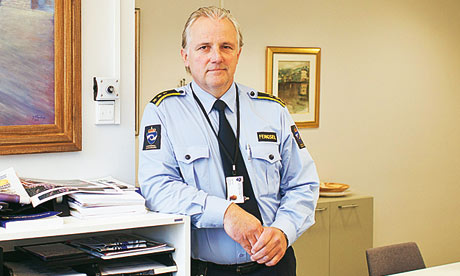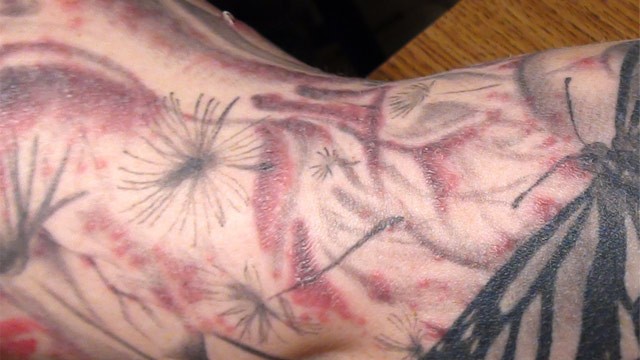Halden prison smells of freshly brewed coffee. It hits you in the workshop areas, lingers in the games rooms and in the communal apartment-style areas where prisoners live together in groups of eight. This much coffee makes you hungry, so a couple of hours after lunch the guards on Unit A (a quiet, separated wing where sex offenders are held for their own protection) bring inmates a tall stack of steaming, heart-shaped waffles and pots of jam, which they set down on a checked tablecloth and eat together, whiling away the afternoon.
The other remarkable thing is how quiet the prison is. There isn't any of the enraged, persistent banging of doors you hear in British prisons, not least because the prisoners are not locked up much during the day. The governor, Are Høidal, is surprised when I ask about figures for prisoner attacks on guards, staff hospitalisations, guard restraints on prisoners, or prisoner-on-prisoner assaults. I explain that British prisons are required to log this data, and that the last prison I visited had a problem with prisoners melting screws into plastic pens, to use as stabbing weapons; he looks startled, says there isn't much violence here and he can't remember the last time there was a fight.
Halden is one of Norway's highest-security jails, holding rapists, murderers and paedophiles. Since it opened two years ago, at a cost of 1.3bn Norwegian kroner (£138m), it has acquired a reputation as the world's most humane prison. It is the flagship of the Norwegian justice system, where the focus is on rehabilitation rather than punishment.
There was early speculation that Anders Breivik, currently on trial in Oslo for the murder of 77 people, might end up here, given that there are few high-security options across Norway, but that now looks unlikely, at least for the first chunk of his sentence. If he is judged to be sane, he will probably remain in isolation in the Ila prison where he is currently being held, a former Nazi concentration camp with a less utopian vision. However, the underlying ethos of Halden prison gives an insight into Norwegian attitudes towards justice, one that is under scrutiny as the country assesses how to deal with Breivik.
When Halden opened, it attracted attention globally for its design and its relative splendour. Set in a forest, the prison blocks are a model of minimalist chic. Høidal lifts down from his office wall a framed award for best interior design, a prize given in recognition of the stylishness of the white laminated tables, tangerine leather sofas and elegant, skinny chairs dotted all over the place. At times, the environment feels more Scandinavian boutique hotel than class A prison.
The hotel comparison comes up frequently. Høidal is just back from visiting a British prison and had to stay a night in a hotel off Oxford Street. Happily for the hotel, he can't remember the name, but he noticed his room was certainly smaller and probably less nice than the cells in Halden. Every Halden cell has a flatscreen television, its own toilet (which, unlike standard UK prison cells, also has a door) and a shower, which comes with large, soft, white towels. Prisoners have their own fridges, cupboards and desks in bright new pine, white magnetic pinboards and huge, unbarred windows overlooking mossy forest scenery.
"There was much focus on the design," Høidal says. "We wanted it to be light and positive."
Obviously the hotel comparison is a stupid one, since the problem with being in prison, unlike staying in a hotel, is that you cannot leave. Even if the prison compound has more in common with a modern, rural university campus, with young and enthusiastic staff (who push themselves around the compound on fashionable, silver two-wheel scooters), the key point about it is that hidden behind the silver birch trees is a thick, tall concrete wall, impossible to scale.
Given the constraints of needing to keep 245 high-risk people incarcerated, creating an environment that was as unprisonlike as possible was a priority for Høidal and the prison's architects. "The architecture is not like other prisons," Høidal says. "We felt it shouldn't look like a prison. We wanted to create normality. If you can't see the wall, this could be anything, anywhere. The life behind the walls should be as much like life outside the walls as possible."
This principle is governed in part by a key feature of the Norwegian sentencing system, which has no life sentences and stipulates a maximum term of 21 years.
"Everyone who is imprisoned inside Norwegian prisons will be released – maybe not Breivik, but everyone else will go back to society. We look at what kind of neighbour you want to have when they come out. If you stay in a box for a few years, then you are not a good person when you come out. If you treat them hard… well, we don't think that treating them hard will make them a better man. We don't think about revenge in the Norwegian prison system. We have much more focus on rehabilitation. It is a long time since we had fights between inmates. It is this building that makes softer people."
Prisoners are unlocked at 7.30am and locked up for the night at 8.30pm. During the day they are encouraged to attend work and educational activities, with a daily payment of 53 kroner (£5.60) for those who leave their cell. "If you have very few activities, your prisoners become more aggressive," Høidal says. "If they are sitting all day, I don't think that is so good for a person. If they are busy, then they are happier. We try not to let them get institutionalised."

‘We don’t think about revenge in the Norwegian prison system,' says governore Are Høidal, 'we have much more focus on rehabilitation.’
The role of the prison guard is very different from that in the UK. While officers in Britain get a few weeks' training, Norwegians will have completed a two-year university course, with an emphasis on human rights, ethics and the law. At Halden there are 340 staff members (including teachers and healthcare workers) to the 245 male inmates. Staff are encouraged to mingle with inmates, talking to them, counselling them, working with them to combat their criminality. A great deal of attention is given to making sure people have homes and jobs to go to when they leave, and that family ties are maintained. (There is a well-stocked chalet-style house for prisoners to receive overnight visits from their families.) "We have many more prison officers than prisoners. They are talking about why they are here, what problems got them into this criminality. Our role is to help them and to guard them. The prison governor role in Norway is unique. They are meant to be coach, motivator, a role model for the inmates."
The regime is expensive – approximately 3,000 kroner (£320) a night, compared with around 2,000 (£213) at the more basic, older Norwegian institutions, such as the Oslo prison where inmates are often locked up for 23 out of 24 hours, but it is cheaper than Ila, where the guard count is higher and the cost 4,000 kroner (£426) a night. A year in Halden costs the state around £116,000, while the average cost of a place in the UK is £45,000.
Cost is only one of the reasons prison reformers in the UK don't think there's any prospect of the Halden model being adopted here. We have double the number of prisoners that Norway has (around 140 per 100,000 in England and Wales, to Norway's 74.8), and having a smaller prison population makes things simpler for the Norwegian state. Halden is so new, there are no figures yet for how swiftly and frequently prisoners drift back into prison after their release, but nationwide Norway has one of the lowest recidivism rates in Europe, just 20% after two years, compared with around 50% in England. Partly that's down to the prison system, but it's also the result of a much better welfare system. There is little popular appetite for softening the prison regime in this country. The justice secretary, Kenneth Clarke, may have stated, "It is just very, very bad value for taxpayers' money to keep warehousing them in overcrowded prisons where most of them get toughened up", but his early commitment to tackling rising prison numbers was not well-received.
The large amount of money and thought lavished on inmates at Halden doesn't stop them (politely) expressing their dislike of the place and their desire to leave as soon as possible. An elderly prisoner, with terminal cancer, serving a long sentence for drug smuggling, is in the craft room, crocheting a toy teddy bear with no enthusiasm for his task. He concedes that Halden smells better than other prisons he has been in, because it doesn't have the mildewed odour of the old buildings, or the deep stench of bodies squeezed together in close confinement. "The only thing that is nice is the building," he says. "People think that you are staying in a five-star hotel, but prison is prison. They lock you up."
Kent, a 43-year-old office manager serving a three-year sentence for a violent attack, is sitting in the prison's mixing studio, where prisoners record music and make a programme that is broadcast monthly by the local radio station. He has formed a band with three other inmates and two guards, and performs regularly for fellow inmates. Leaning back in his swivel chair, sipping at his coffee and fiddling with his red baseball cap, he admits he's enjoying being able to focus on his music, but says, "The Halden prison has been compared to the finest hotel. That's the impression my friends and parents have from reading the papers. It is not true. The real issue is freedom, which is taken away from you. That is the worst thing that can happen to you. When the door slams at night, you're sat there in a small room. That's always a tough time."
He has children aged 10 and 12. "I think about them 24/7. I speak to them three times a week for 30 minutes, but there is so much to say, so much I need to be doing for them. I think I'm never going to commit another crime. Freedom means so much to me."
There is some annoyance from staff at the focus on the buildings, rather than on the principle of rehabilitation that drives the prison. "One politician when it opened said, 'I could live here for a year, no problem.' But he was in the cell for two minutes," says Janne Offerdal, who teaches English to the inmates (mainly to foreign nationals caught smuggling drugs into the country; the Norwegian prisoners all speak impeccable English). "They compare the facilities with the elderly prisons. But if you are building a new building now, you wouldn't build an old one."
Høidal is bemused by the popular fascination with the prisoners' flatscreen TVs, pointing out that it's now impossible to buy the older models. "I don't call the cells luxurious. It's 10 square metres, a toilet, a shower, that's all."
No one is thrilled to arrive here. The reception officer explains that the most positive reaction is one of relief. When they are brought in, "some of them are crying," he says. "They don't know what they're going to do with their dog. There are aggressive people who are high on drugs, or withdrawing from drugs, which is not always easy to deal with. It's only the older guys who've been in other prisons who are happy to be in Halden."
As we walk around the compound, an inmate comes up to ask Høidal, "Can we have a swimming pool?" He laughs, and remembers the shock of a Russian prison governor who visited recently and was horrified to see that the inmates didn't stand to attention when Høidal came past but instead clustered around him, seizing the chance to list their complaints.

Halden has an award for its interior design. At times, the environment feels more Scandinavian boutique hotel than class A prison.
There are no plans for a swimming pool, but Høidal does want to make a jogging track through the woods, and a young sports teacher (who is working on specialised programmes for recovering drug addicts) says he hopes to start rock climbing lessons in the summer.
I wonder if it's a good idea to teach inmates how to scale rock faces, but he responds with hurt amazement. "There would be no security risk. I wouldn't be teaching them how to escape." So far there have been no escapes, or attempts.
The sports centre is focused on team sports, especially football. There are a few bits of training equipment, but no weights, because Høidal doesn't approve of them: "I see the negative of focusing too much on muscles. It is a violent thing."
The inmates tell Høidal they're annoyed by recent changes to the routine, but they are respectful when they address him. He listens politely, agrees that in prison minor irritations can become major frustrations, but remarks that people outside the building would laugh at the trivial nature of their complaints.
In the winter, when the compound was covered in snow, one of the inmates went outside and stamped around for a while. Looking out from the staff canteen later, guards noticed he'd written Help Me with his footprints. A UK prisoner might set fire to his cell; even these appeals for attention are done in the most non-aggressive manner.
I see only one piece of prisoner graffiti, a rather half-hearted scribble on an A4 printed notice (to avoid causing permanent damage): "Fuck the rules" (only the pen has stopped working, so all that's really legible is Fuck the r). Otherwise, there is the prison-sanctioned graffiti, the recurring logo of a convict in striped uniform, apparently about to hurl his ball and chain to the wind, which decorates the yard walls and toilet doors, and was commissioned at considerable expense from the Norwegian graffiti artist Dolk, out of the prison's 6m kroner (£640,000) art budget.
Huge, blown-up photographs of daffodils, Parisian street scenes or Moroccan tiles cover the corridors. Høidal doesn't have a clear answer to whether the pictures have a positive effect on inmate behaviour, but says that whenever a state building is opened in Norway, 1% of the construction budget goes on art.
One wild-eyed ex-amphetamine addict slaps Høidal on the back, tells him he is a good man, but says he misses his old prison, Oslo, where he served an earlier sentence. Drugs were more of a problem in that jail, he adds wistfully. Høidal agrees that the style of Halden prison, with the relentless presence of guards wanting to talk and help inmates, does not suit everyone. "Some people don't like them being around all the time. If you want drugs, then you prefer Oslo prison."
Another prisoner, living in the relative seclusion of Unit A, where he is a year into a sentence for sexual abuse of a minor, pays tribute to the humanity of the prison staff (as opposed to that of the fellow prisoners, who, when they found out what he was in prison for, announced they were going to dismember him). "The people who work here don't look down on you," he says. Compared with the 1850s Eidsberg prison, where he was before, Halden is a relief: "Being there and being here, it's like heaven and hell."
Two prison officers are sitting with the eight prisoners on A-block, encouraging them to knit woollen hats. One also has expensive oil canvases for them to experiment with, but there isn't much appetite for either activity, so once the waffles are finished, they return to playing a card game.
The civility between staff and inmates is noticeable everywhere. Information for new inmates is translated into English for those who do not speak Norwegian. The text is apologetic about the possibility that they may have to wait before they are transferred to a cell, and concludes: "We hope you have understanding for any waiting and hope to help you as soon as possible. With best regards, the reception officers."
Maybe I'm not there long enough to sense latent anger or profound despair, but Halden doesn't feel like a place where you have to look over your shoulder. An official in the healthcare division says up to 40% of inmates will be taking sleeping pills, and between 10% and 20% are on anti-depressants, but overall the atmosphere is calm.
Though food is provided by the prison, inmates can buy ingredients to make their own meals. The prison shop has wasabi paste for those who want to make sushi. You can buy garam masala, vanilla pods or halva, and there is prime fillet of beef at 350 kroner (£37) a kilo, which prisoners club together to buy when they want to make a special meal. The most frequently borrowed books in the library are cookbooks. Most prisoners' fridges are full of yoghurt drinks and cheeses; a couple say they've put on weight since they arrived.
At 3pm, a table is set for 10, with white china plates, glasses and white paper napkins, in the drug rehabilitation unit, where Robert, 45 and an ex-addict and dealer, is living. Some prisoners are sitting on the brown woollen sofas watching the communal television. It looks like an advertisement for a family ski-chalet, complete with beautiful forest views. This is the main meal of the day; afterwards, between four and five prisoners will be locked in their cells for an hour to give the prison guards time for a break, then there will be free time until lock-up at 8.30pm.
Occasionally the prisoners talk of the Breivik trial, which is closely followed on television. On the whole they don't believe the liberal regime from which they benefit should be extended to him. "He couldn't stay in a place like this," Robert says. "If I saw him, I would knock him down. I'm a nice prisoner but I would do it and I would brag about it. Everybody wants to take him out."
A fellow inmate, Patrick, serving a 12-year sentence for drug smuggling, was one of two prisoners who organised a prison-wide collection to buy flowers for the victims of Breivik's attack. Everyone gave up their daily wage of 53 kroner (£5.60); even the prime minister was moved by the gesture. "It was horrible, the thing that happened, and we felt helpless," Patrick says. "We wanted to do something. I was surprised that it got so much media attention; I was surprised that people thought, 'You're prisoners, but you are so nice.' We are also human beings. We also have daughters, sisters, children."
Høidal says, with some relief, that if Breivik is ever transferred to Halden, it won't be for at least a decade, by which point he will have retired. Although special arrangements may have to be made for the first stage of Breivik's incarceration, he believes the Norwegian principles of fair and liberal punishment will not be threatened by the atrocity. In the days after the attack, the Norwegian prime minister, Jens Stoltenberg, said, "We are shaken but we will not give up our values. Our response is more freedom, more democracy."
Høidal echoes his words: "If it happens again, then maybe we will have another discussion about the system. For the moment, I don't think that this case will change Norwegian thinking."








 LIVING IN A FASCIST STATE: Mentally ill people need to be helped, not hounded
LIVING IN A FASCIST STATE: Mentally ill people need to be helped, not hounded

 ‘We don’t think about revenge in the Norwegian prison system,' says governore Are Høidal, 'we have much more focus on rehabilitation.’
‘We don’t think about revenge in the Norwegian prison system,' says governore Are Høidal, 'we have much more focus on rehabilitation.’ Halden has an award for its interior design. At times, the environment feels more Scandinavian boutique hotel than class A prison.
Halden has an award for its interior design. At times, the environment feels more Scandinavian boutique hotel than class A prison.





